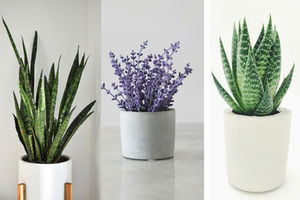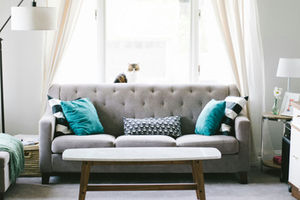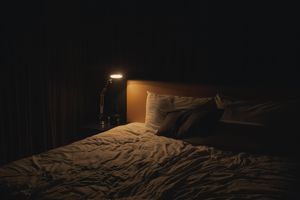
Get a bed that gives your body sufficient support while you sleep. Keep your bedroom clutter-free. PHOTO/EDGAR r. BATTE.
“Living space can directly impact mood and anxiety. With increased clutter or disorganisation in a person’s personal living space, it can feel like there is no safe place to recover from life,” writes therapist Billy Roberts.
As such, keeping clean and clear interior or exterior spaces is one way to support and maintain your emotional well-being and mental health. Interior designers answer the questions about the kind of home they would set up for someone who is stressed out about work and needs to return to a home with a calming and therapeutic environment.
Declutter
“What determines the choice of the set-up?” I ask Lyn Bahati, the director at House of Ndinda. “Psychology in design elaborates how certain spaces affect the mood and productivity of an individual so elements such as colour and fabric can contribute to or derail someone’s mental well-being which is why it is important to engage a client for a consultation to better understand their personality before recommending styles and furnishings for their spaces,” Bahati elaborates.
Phillip Luwemba, another designer, thinks that for every home, the idea of interior design and architecture is meant to answer the very question of what determines the choice of the set-up for one to achieve mental well-being. “It is what the whole of interior design is about,” he stresses.
Bahati says one way of setting up a home that promotes well-being is using minimal decor pieces and furniture. This means including only the things the homeowner holds dear, and creating the kind of that keeps the rest of the stuff out of sight. She further recommends incorporating open-floor designs to allow for natural light and seamless living.
Feng Shui
Diane Gallin, a Feng Shui consultant recommends Feng Shui for someone is experiencing mental health problems. She believes Feng Shui can help in their environment by addressing some of the issues affecting them.
“For example, if a person is feeling sad or depressed, I recommend evaluating their space to see that there are no dark or dreary images both inside or outside like dead trees or plants, broken furniture, images of dead-end streets, stark landscapes, lots of clutter, nighttime photos and lack of windows, among others,” Gallin explains.
She observes that human beings respond to uplifting images, healthy plants, blooming gardens, light/airy spaces where they can move around freely. Artwork that brings a smile to your face or photographs of good times and friendly people tend to make a person feel more optimistic.
Gallons adds, “It is also recommended to keep floors clear of storage items because clutter drags energy downward to your feet instead of upward to your head. Artwork and mirrors should be hung at eye level of the tallest person in the home.”
The Feng Shui expert says if someone wants to cultivate relationships, round shapes such as a round table, bowl or mirror, suggest togetherness and cooperation. Similarly, pairs of items or images of couples promote wellness can be uplifting and feelings of connectivity.
“I once had a client who was trying to improve relationships and all the artwork in the home had images of one person, animal or focal point in it, so that is what was being reinforced every day. She was not even aware of it until I pointed it out. It is believed that we attract the images we have around us so good to keep them optimistic,” she narrates, emphasising that if a person has a hectic lifestyle or busy/stressful job, it is very important to create a peaceful home environment to restore their energy.
Tone it down
Exposing oneself to beautiful images requires placing them in spaces where they can be easily seen. Gallin also advises that organising drawers and closets makes it easier to locate items when you need them. Soothing paint colours are also good for slowing things down; neutral off-white, pink, pale yellow, green or blue shades are especially relaxing. If you want a pop of colour add orange or red in moderation to your decor which will blend in without interfering with the peaceful colour scheme.
Luwemba adds, “The interplay of colours in itself will affect someone’s mental well-being. A calm colour scheme, in the right places, sets the scene for one’s morning and their end of the day, which will encourage sleep and ultimately improve mental stability if done right.”
Bahati suggests a colour palette that is soft but warm, and nothing too heavy on the eye such as pastels and whites. This goes for the furniture too. To balance out the neutrals just add colour hints using smaller items for example orange or red in throw cushions or a piece of art.
Bahati adds, “A good couch comes in handy on a particularly stressful day. Add hues of the outdoors such as indoor plants that thrive with minimal attention.”
Luwemba notes that badly designed furniture such as chairs and beds are bad for one’s mood and well-being. “Sleeping in a bad bed will result in pain in your whole body, which affects your mood. It is important, therefore, to get the kind of seats that caress your body and a bed with that supports you as you sleep,” he says.
Use space right
Soft fabrics soften hard metal and wood surfaces while round and wavy shapes add dimension to a square room or angular furniture. “I always recommend playing soft, soothing music when trying to relax because it lowers blood pressure and helps instill calmness,” Gallin further tips.
According to Luwemba, a well-laid out space implies ease of use and with that ensures a better user experience which he believes reduces stress. Bahati says ultimately, a designer’s goal is to create a relaxing environment but the client’s input is very important to give spaces personality and for one to see themselves and belong in the general outlook of the design.
When deciding how to set space up, Gallin suggests starting with the floor plan and room arrangement, and then deciding how they will be used.
“The front door should be wide and clear of clutter so that (chi) energy can find its way into the home,” she advises. Luwemba suggests designing social spaces that encourage play and interaction instead of the now popular all-white spaces many Ugandans are embracing that limit them and their children from playing freely. In a nutshell, architecture and interior design, if done well, ensure a better mental being through its elements of space, décor, furniture, colour and textures.





